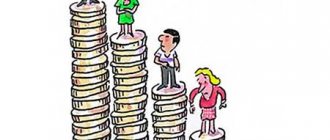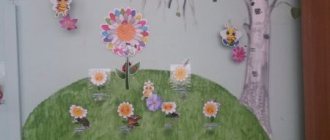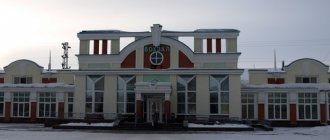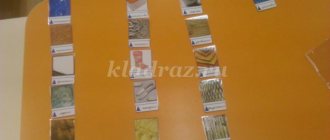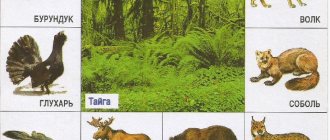Visual information material on the lexical topic “Family”
The speech therapy corner plays an important role in working with families. Visual information material on the lexical topic “Family” can be used to design a speech therapist’s corner in the middle group. This material includes games for the development of fine motor skills, games for the formation of lexical and grammatical categories, tips and recommendations for parents on conducting conversations with their child on the topic being studied.
Visual information material on the lexical topic Family
Check if your child knows:
- What is family (relatives, relatives)?
- The composition of your family?
- Names of immediate family (sister, brother, uncle, grandmother, etc.)?
- Mom and dad's first and middle names, their professions?
- Who is he to grandparents (grandson, granddaughter), to parents (son, daughter), to brother and sister?
Do the “Family” finger exercise with your child:
This finger is grandpa, (we bend our fingers one at a time, starting with the thumb on one hand) This finger is grandma, This finger is dad, This finger is mom, This finger is me, Together we are a friendly family. (we interlock and squeeze our fingers) These fingers are grandfathers, (we bend the fingers on both hands) These fingers are grandmothers... These fingers are girls and boys.
Together with you we teach children.
Explain to your child what a family (relatives) is. Name all members of your family (mother, father, son, daughter), look at photographs of your closest relatives (grandfather, grandmother, aunt, uncle).
We call family members affectionately.
Explain to your child that you can call him simply by name (for example, Masha), or you can call him affectionately (Mashenka). And all family members can also be called affectionately: mother - mommy, mommy, grandmother - granny, granny.
Come up with as many kind words as possible.
We name family members in singular and plural.
1. Game “One or several”
Instructions: you have a grandmother, and the guys have... who? (grandmothers) You have a sister, and the other guys have... (sisters)
2. Game "One-many"
Instructions: one daughter, but many... who? (daughters)
We use adjectives in speech.
Invite your child to come up with two or three beautiful words about each member of his family:
- Mom (which one?) – good, kind, beautiful.
- Dad (which one?) – tall, strong, etc.
We use verbs in speech.
Invite your child to answer what mom/dad/sister/grandmother, etc. is doing.
- Mom (what does she do?) – cares, loves, hugs, cooks
- Dad (what does he do?) – fixes, plays, works, helps, etc.
Pick up lotto pictures or find a picture of a family. Let the child answer by looking at the pictures - this will help him quickly find the correct answer and assimilate the acquired knowledge on the lexical topic “Family”.
Zhurakovskaya Yanina Viktorovna, teacher-speech therapist of the highest category, GBOU kindergarten No. 864, Moscow
- Speech therapy exercises on the topic “My Family”
- Information block for parents on the lexical topic “Wild Animals”
- Visual material on the lexical topic “Wintering birds”
- Didactic material on the topic “Our home, our city, our country”
- Information for parents of the preparatory group on the lexical topic “Late autumn, Wild animals are preparing for winter”
( 2 liked, average score: 3.50 out of 5)
Loading...
Summary of a subgroup speech therapy lesson in the senior group on the topic: Family
Summary of a subgroup speech therapy lesson in the senior group on the topic: “I know that I have a very friendly family.”
Description of the material : I offer you a summary of the direct educational activities of children in the senior group on the topic: “I know that I have a very friendly family.” The material will be of interest to speech therapists, teachers and other preschool specialists. This summary may be entertaining. Integration of educational areas: “Cognition” (formation of a holistic picture of the world), “Socialization”, “Communication”, “Physical education”, “Health”, “Music”. Goal: To form in children a correct idea of the family, the role of father, grandfather, grandmother, sister, brother. Objectives: 1. Clarify and generalize children’s knowledge about the family, about who their relatives are. 2. Strengthen the understanding of the work responsibilities of family members. 3. Train children in the ability to ask questions and choose the right adjectives and verbs for words. 4. Develop coherent speech, cognitive interests, logical thinking. 5. Cultivate love and respect for your family members. Preliminary work: 1. Learning the last name, first name, patronymic and profession of parents. 2. Looking at family photos. 3. Making a family tree by parents. 4. Drawing pictures on the theme “My family.” Equipment: Family photographs, tree diagram, basket, bees, teddy bear from the puppet theater, photo exhibition.
Progress of the lesson:
Speech therapist: Children, let's imagine that we were all invited to a television studio for a children's program - “My Family”. Do you agree to be participants in this program? (Children's answers). Then let's quietly enter the television studio and take our seats. (Children sit on chairs to the music). Are the TV show participants ready? (Children's answers). Well, then we started. — Good afternoon, dear TV viewers. We are starting our program - “My Family”, and I, its presenter Galina Vladimirovna, greet you. Today in our studio there are guests of the program and participants, children of the Vesnyanka kindergarten in the village. Chertkovo. I invite participants to introduce themselves. Children: My name is..., my last name is.... Speech therapist: - Now I will tell you a riddle and, having guessed it, you will find out the topic of our conversation. The people who are dearest and closest to me, without whom I cannot live. We always take care of each other. This is my friendly... family. (Children). - That's right, today we will talk to you about family. - Children, listen, someone is rushing to our studio. Little Bear: - Hello, guys! You recognized me? My name is Mishutka. Guess which fairy tale I came to you from? Yes, I come from the fairy tale "The Three Bears" and I want to show you a photo of my family. This is dad - Mikhailo Potapych, he is big and strong, and this is mom - Nastasya Petrovna, she is kind and affectionate, and this is me - Mishutka. Our family is small, only three people. I love mom and dad very much. They also love me very much and care about me and each other. Guys, do you have a family? Tell me about your family and how you live. Speech therapist: Children, let’s tell you on our fingers about your family. Finger game: “My family.” — Today we have a photo exhibition on our TV show, many of you made a photo collage with your parents. Our TV viewers and Mishutka will be interested in hearing stories about your families. (Children tell: who is depicted; their parents’ names, where they work, where they filmed). - Who is our brother, who is our friend, quickly stand in the circle! Let's take each other's hands and start playing now. Game: “Who are you to me?” Children in a circle, the teacher asks: “I am a mother, and who are you to me?” (Daughter, son)… . Speech therapist: - Children, today we talked a lot about family, and now I want to tell you that a family is like a huge tree, the roots of this tree are the parents of your grandparents (your great-grandparents). The thick branches of the tree are grandparents. The thinner branches are your fathers and mothers, and the thinnest branches are you children. Now let's listen to children who have not yet talked about their family. (Story by 1-2 children). Physical exercise: “Who lives in our apartment?” Who lives in our apartment? One two three four. (We clap our hands.) Who lives in our apartment? (We walk in place.) One, two, three, four, five. (Jumping in place.) I can count everyone: (We walk in place.) Dad, mom, brother, sister, (Clap our hands.) Murka the cat, two kittens, (Tilts the body to the right and left.) My cricket, the goldfinch and me - (Turns the body left and right.) That’s my whole family. (Clap our hands.) Speech therapist: Children, I am very glad that each of you has a home where you are loved, waited for and cared for. -And if one of the family members is in a bad mood, what words can you use to correct it? You know such magic words , then let's play: 1. An ice block will melt, from a warm word - thank you 2. An old stump will turn green when you hear - good afternoon! 3. When people scold us for pranks, we say, please forgive me. - I see you are very attentive, kind children. In my hands (the game is being played) “Basket of Good Deeds” bees live in it. You need to catch a bee, put it in a basket and name the good deed that you are doing at home. (Music sounds, children take turns naming their chores). Speech therapist: Children, guests came to our TV show. Let's invite them to the studio. Please come in and have a seat. Our guests are Artem Reshetnikov’s mother, Ekaterina Petrovna, and Yurchenko Bogdan’s mother, Natalya Viktorovna. Dear guests, our children have already told us what tasks they carry out in their family, and now they want to know how responsibilities are distributed among adults. Can we ask you a few questions? And so the first question. (Children ask their own questions: who in your family goes to work, knits socks, bakes pies, hammers nails...). -Thank you very much to our guests for participating in the TV show.
We recommend watching:
Summary of an individual educational activity with a 5-6 year old pupil on the correction of sound pronunciation Summary of a subgroup lesson for children 5-7 years old in kindergarten on sound automation [R] Subgroup speech therapy lesson on the formation of phonemic functions in the senior group of children Synopsis of a subgroup speech therapy lesson on sound automation R in proposals
Similar articles:
Summary of educational activities in the older group of children with severe speech impairments on the topic: “Sounds S - Z”
Summary of educational activities in the senior group of children with severe speech impairments on the topic: “Sounds S - Sh”
Summary of a subgroup GCD to eliminate disturbances in sound pronunciation in children of the older group with severe speech impairments
Summary of educational activities in the senior speech therapy group on the topic “Cossacks and their traditions”
Logorhythmic lesson for children of senior preschool age with special needs on the topic: “What types of transport are there?”
